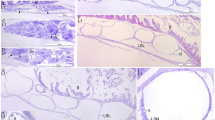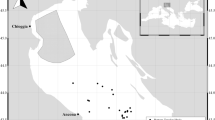Abstract
ALTHOUGH we now have a complete description of the fully-developed larva1 of the European oyster (Ostrea edulis), we have as yet no account of the metamorphosis which takes place when the larva attaches itself and becomes the settled spat. The smallest spat yet described is that figured by Yonge2 The shell of this individual measured 1.2 mm., whereas the shells of fully-developed larvæ before settlement average only 0.30 mm. There is therefore a considerable gap which requires to be bridged by the description of smaller spat.
This is a preview of subscription content, access via your institution
Access options
Subscribe to this journal
Receive 51 print issues and online access
$199.00 per year
only $3.90 per issue
Buy this article
- Purchase on Springer Link
- Instant access to full article PDF
Prices may be subject to local taxes which are calculated during checkout
Similar content being viewed by others
References
Erdmann, Wiss. Meersunters. abt. Helgoland, 19, No. 6 (1933).
Yonge, J. Mar. Biol. Assoc. (n.s.), 14 (1926).
Stafford, ” The Canadian Oyster” (1913).
Author information
Authors and Affiliations
Rights and permissions
About this article
Cite this article
COLE, H. Metamorphosis of the Larva of Ostrea edulis. Nature 139, 413–414 (1937). https://doi.org/10.1038/139413b0
Issue Date:
DOI: https://doi.org/10.1038/139413b0
This article is cited by
Comments
By submitting a comment you agree to abide by our Terms and Community Guidelines. If you find something abusive or that does not comply with our terms or guidelines please flag it as inappropriate.



